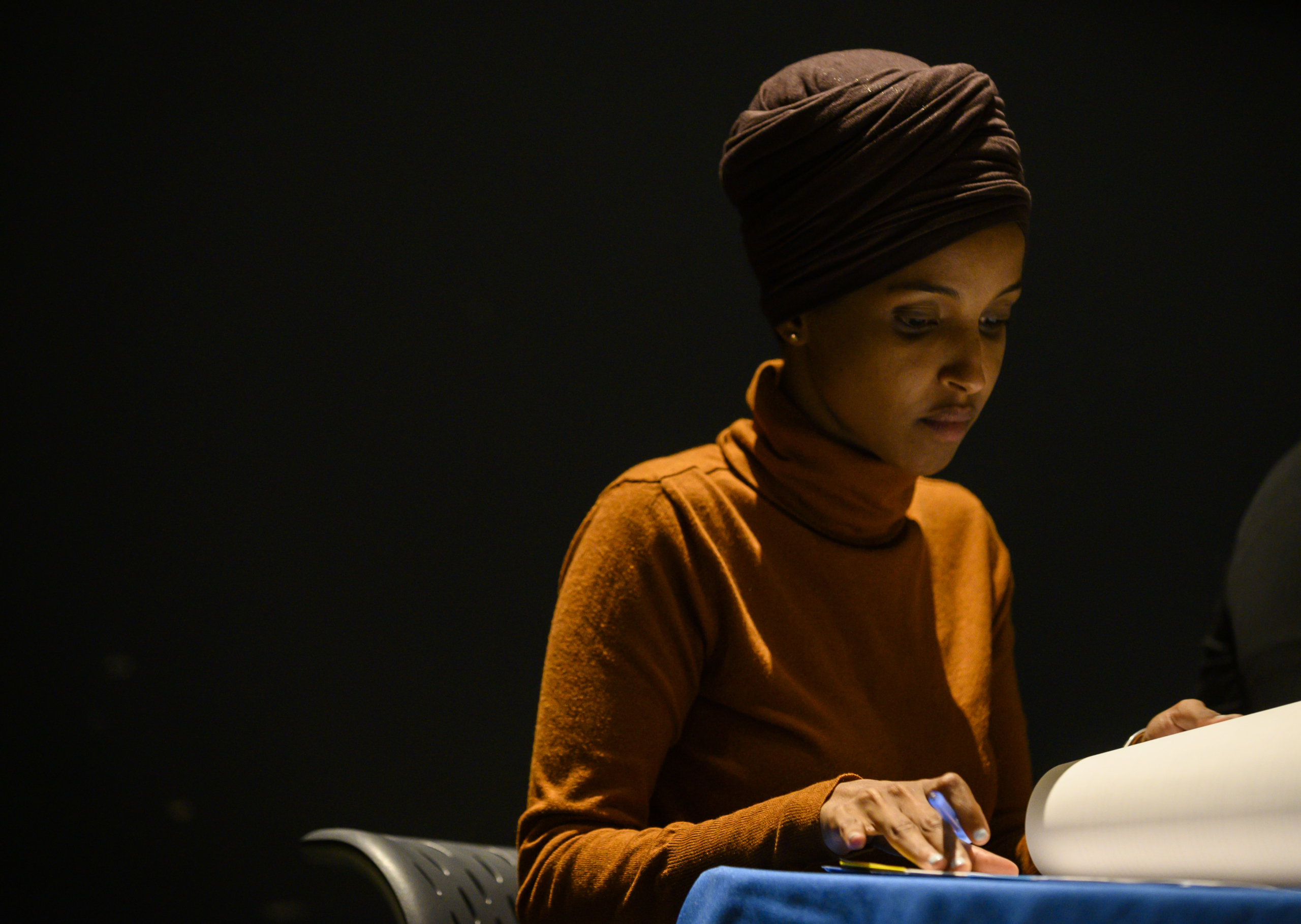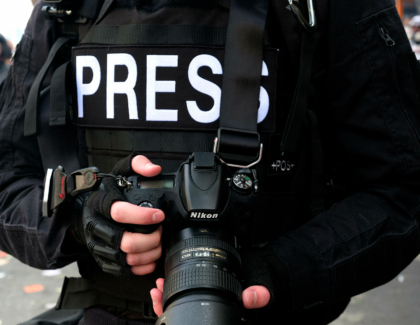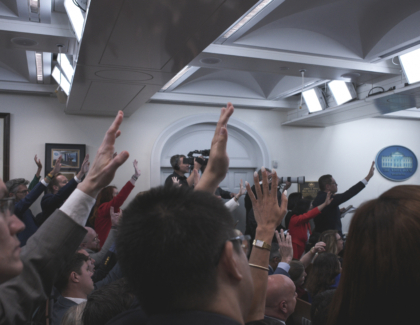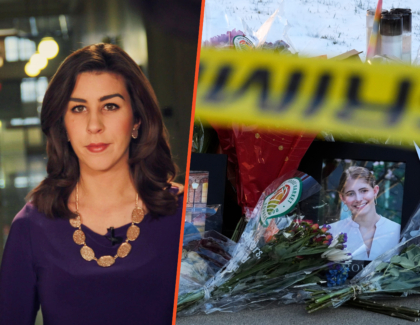Sign up for the daily CJR newsletter.
On October 10, Donald Trump came to downtown Minneapolis, the center of a liberal city that overwhelmingly voted against him in 2016, for his first campaign rally since House Democrats initiated impeachment proceedings. Inside the Target Center, the president disparaged the city’s sizable Somali population and called US Rep. Ilhan Omar “a disgrace to our country.”
Outside the rally, protestors gathered in droves, chanting in front of a giant baby Trump balloon atop famed rock club First Avenue and waving signs. “So bad even introverts are here,” one of them read. It was mostly a peaceful scene, due in part to a fence that separated protestors from the lines of people filing into the arena. Later in the evening, as the rally neared a close, some attendees crossed the line to find their cars and ran into protestors. Along with my colleagues from the Minneapolis Star Tribune, I saw a few punches thrown, some MAGA hats burnt, and one Trump supporter wave a gun inside his car. It was dark and raining, which rendered my notebook useless, so I documented the clashes with my phone. That night, I published three videos to my Twitter account via Periscope; the footage totaled about 40 minutes.
The next day, I encountered tweets and a video clip that purportedly showed Omar at the protest, which had been billed as an “Antifa rally” and a “riot.” The clip, which was just a few seconds long and has since been republished in many forms, had been excerpted from my video coverage. It showed a young woman wearing a headscarf and a man wearing a ski mask and glasses. The edited clip then juxtaposes images of Omar and Tim Mynett, a political strategist alleged to be dating Omar, with the figures I’d filmed. I was surprised to see some on Twitter and Instagram credit me and the Star Tribune with having “exposed” Omar and Mynett.
“Dude! You just got Omar and her lover on tape,” one Twitter user said.
RECENTLY: The New York Times’ Trump obsession, quantified
Tony Shaffer, a former intelligence officer and advisory board member for Trump’s 2020 campaign, shared a screenshot of the video with his 88,000 followers and wrote that Omar “participated in the Antifa riot to attack Trump supporters.” Shaffer’s tweet was reshared nearly 9,000 times. Conservative news sites such as The Blaze picked up the story; so did countlessblogs and message boards I’d never heard of.
As the story went viral, I decided to do something none of the people sharing it had bothered to do: investigate whether it could possibly be true.
It was too late. A lot of people had already consumed the misinformation.
SUCH VIRAL RUMORS are a quandary for local newsrooms. By reporting on these claims, even to fact check them, news outlets run the risk of bringing them to a wider audience, legitimizing them as bona-fide conspiracy theories, and ultimately doing more harm than good. Yet some stories will reach a mass audience whether we write about them or not. In an era when online hoaxes drive people to shoot up pizza parlors and harass the grieving families of school-shooting victims, doesn’t correcting the record become a journalist’s remit?
In Minnesota, there has been a rise in hoaxes meant to demonize the Somali community since Omar’s election to Congress. In February, right-wing provocateurs Laura Loomer and Jacob Wohl released a series of videos from Minneapolis in which they falsely claimed that “Sharia police” patrolled our streets. In the Star Tribune newsroom, their visit led to a spirited debate among reporters and editors on how–or whether–to cover it. Ultimately, Jennifer Brooks, our metro opinion columnist debunked the pair’s allegations without naming Loomer or Wohl. “They aren’t worth the ink it would take to print their names,” Brooks wrote. “But this weekend, they cast lie after lie after lie into the wind, describing a Minneapolis that is a terrifying wasteland, safe only to travel in armored cars and with bulletproof vests. We don’t know who’s waiting downwind, believing every word.”
In September, following reports of a brutal assault in downtown Minneapolis, social-media users blamed Somali residents in Omar’s district for the attack. A video from the Daily Caller made the same claim. However, none of the assailants were Somali, according to police. Mukhtar Ibrahim, editor and executive director of Sahan Journal—a nonprofit news site focused on immigrant and refugee issues—wrote about the incident and engaged the misinformation from the outset. “Right-wing social media users and digital websites masquerading as legitimate news sources are spreading misinformation about a robbery and beating outside Target Field in downtown Minneapolis,” wrote Ibrahim. Though the Daily Caller amended its story, Ibrahim says, “it was too late. A lot of people had already consumed the misinformation.”
People are still sharing the false claim, including a Republican who is running against Omar, sending it to a wider audience.
ON ITS FACE, the claim about Omar attending an antifa riot didn’t make sense. There was no riot—a fact Minneapolis police spokesman John Elder confirmed when I reached out to double-check with him.
If Omar had attended the protest, then it seemed unlikely she’d try to conceal her presence—especially in a place where she’s more likely to be recognized than anywhere else in the world, at an event with TV cameras, and with a man she’s trying to convince the press isn’t her boyfriend. I contacted Jeremy Slevin, Omar’s aide, who told me Omar had been in Morocco the night of the rally. To confirm the dates of the trip, I reached out to US Rep. Karen Bass, who’d traveled with Omar. Bass’s aide confirmed the two had been together on the other side of the planet the night of the rally.
I suspected the word of Omar and a fellow Democrat wouldn’t be enough to convince the deep skeptics, so I asked Slevin what evidence he could show me from the trip. He sent me photos of Omar in Morocco, along with a picture of Omar’s plane tickets, which showed an October 11 return date—the day after the Trump rally.
Four days after the protest, I received a call from Beatrice Dupuy, a former colleague who now works for the Associated Press and who was fact-checking the same claim. Her independent reporting corroborated my conclusion, and mine hers: the claim was false. My editors ran the AP’s version of the fact-check, and I posted it to Twitter, along with a thread laying out the evidence I’d collected.
I wish I could say my experiment yielded a revelation. Instead, my thread only strengthened the resolve of some of Omar’s biggest critics, who replied that they did not believe me any more than they believed Omar. Some took my reporting as evidence that I am part of a coverup. One blogger dredged up photos from my wedding and insulted my wife, who is also a journalist. This blogger used “facial recognition” software to prove it was Omar and Mynett (the glasses are a 94-percent match!), claimed I knew Omar and Mynett (I don’t), and that a “progressive network”—me, my wife, and a journalist I’ve never met—may have had a role in “engineering this event.” The same blogger later concluded we’d planted body doubles of Omar and Mynett to create a “publicity stunt” meant to discredit online theorists such as him.
I checked to see whether any of the social-media accounts that helped popularize the misinformation about Omar had corrected it, but I found none. People are still sharing the false claim, including a Republican who is running against Omar, sending it to a wider audience.
In a recent New York Times op-ed, a trio of researchers who reviewed 90,000 tweets mentioning or tagging Omar found that “roughly half…included hate speech or Islamophobic or anti-immigrant language,” and “almost 60 percent of the network of accounts that mentioned or tagged her had posted at least one tweet containing hate speech of overt disinformation.” The false claims were amplified by bots, then shared by “ordinary” users who were “swept up in the rancorous energy of the crowd.”
Running for public office invites public scrutiny and, with it, the possibility of vehement criticism. But legitimate criticism—the sort that keeps public officials accountable—should depend on truth, which journalists are obligated to defend and which, in the cases of Omar and Minneapolis’ Somali community, is too often absent. I know that viral hoaxes won’t go away until people stop sharing them and social-media platforms weed them out. The former may never happen; efforts at the latter are nascent. Journalists shouldn’t wait for either.
ICYMI: Letting the televised impeachment hearings play out
Has America ever needed a media defender more than now? Help us by joining CJR today.







